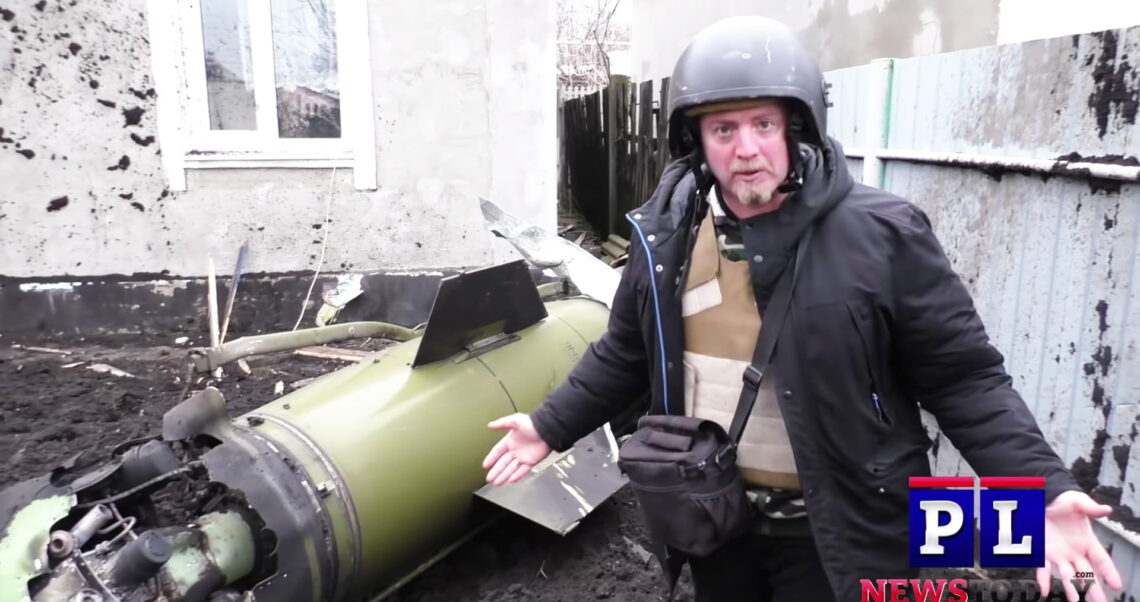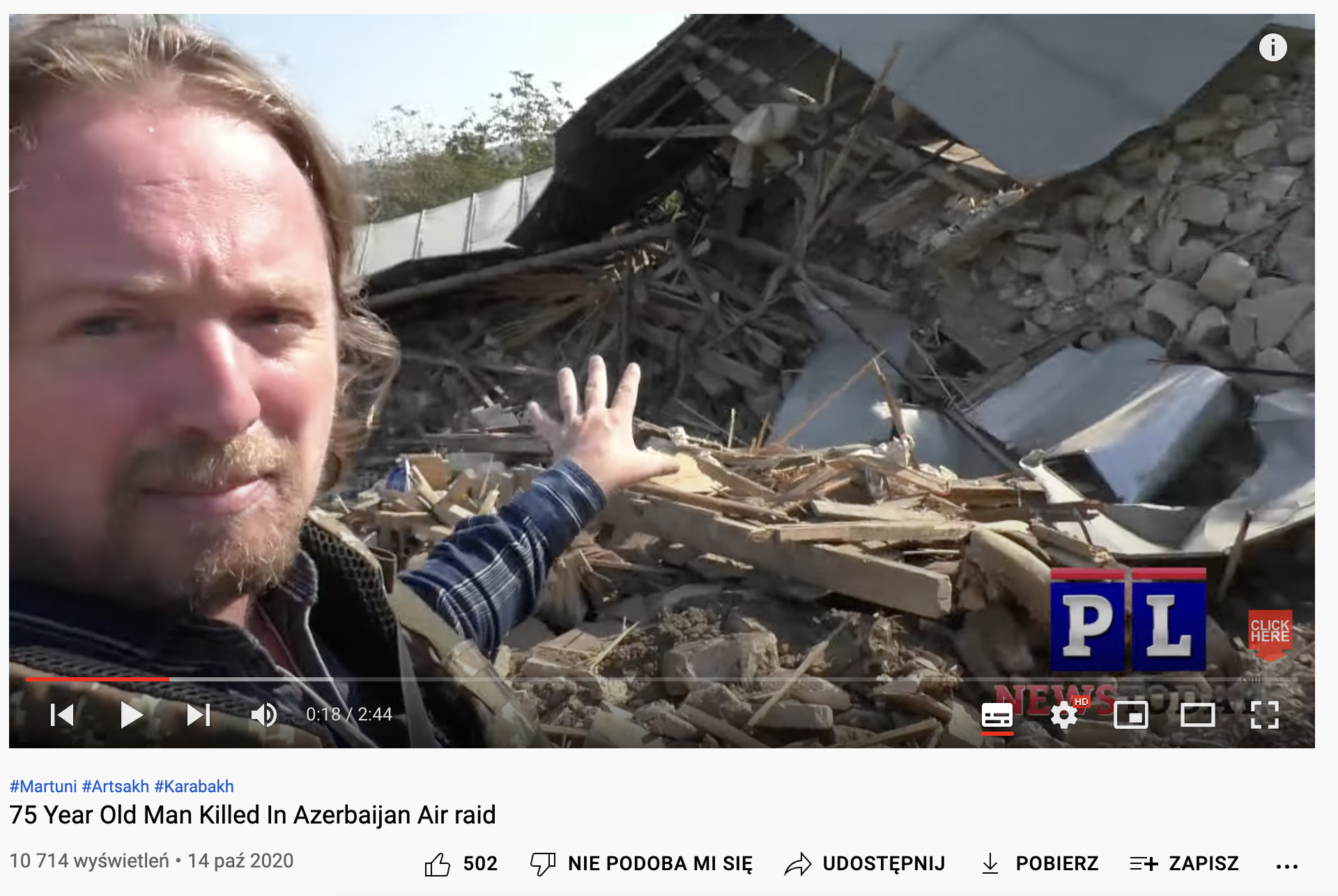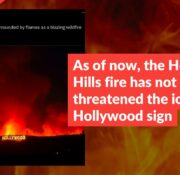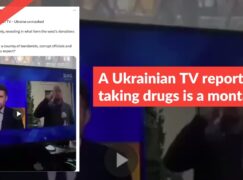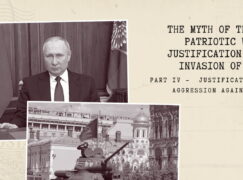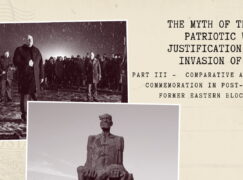Patrick Lancaster describes himself as a fully independent journalist, who shows stories entirely missed by mainstream media. How it really is? What narrative does Lancaster build, what techniques of manipulation does he use?
Patrick Lancaster claims to reveal the reality as it is from the perspective of an “ordinary man”, not political interests. As he declares, he was present in the separatist republics, i.e. the Donetsk People’s Republic and the Luhansk People’s Republic, longer than any other Western journalist, what provided him a detailed insight into their realities – what are the facts? Let’s check it.
Let’s take look at a short biographical sketch of Patrick first. As Lancaster himself states on his VK profile, he was born on July 30, 1982 in St. Louis, Missouri. There he graduated from the private Catholic Bishop Dubourg High School, and then he joined the United States Navy. More detailed description of his professional experience can be found on his LinkedIn profile:
From 2001 to 2006, he served on the aircraft carrier USS Kitty Hawk with the rank of Second Class Petty Officer. From 2014 to 2016 he worked with Thomson Reuters agency, and between 2015 and 2017 with Sky News as an independent journalist and freelancer. Between 2014 and 2017, he worked with Ruptly – Russian national news agency delivering on-demand materials.
It is also worth to mention that in 2017 Lancaster got married “under” the law of the Donetsk People’s Republic, which was broadcast on television led by the Ministry of Defense of the Russian Federation. Moreover, Lancaster’s outfit matches the colors of the unrecognized Donetsk People’s Republic flag, and among the guests Dejan Beric was present – a Serbian sniper fighting on the Russian Federation’s side.
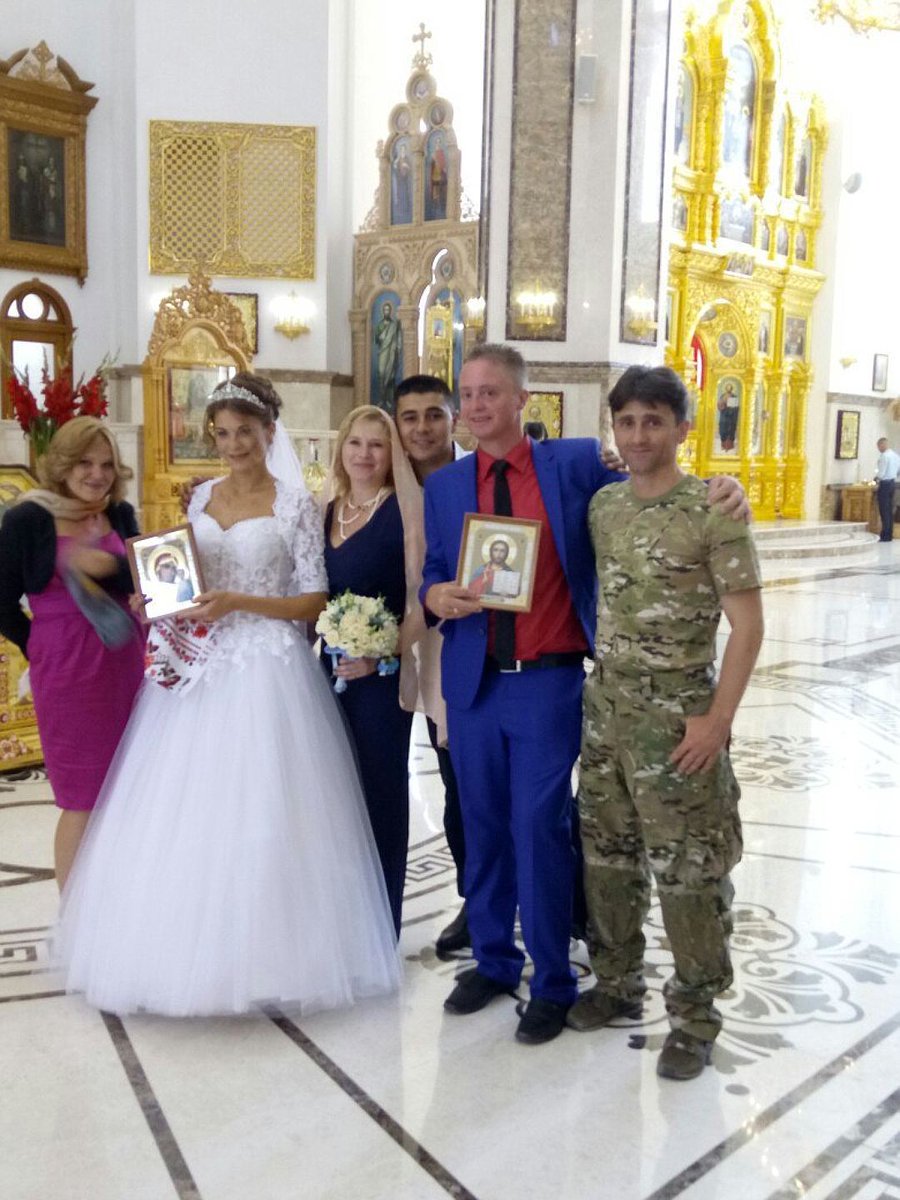
As he states, YouTube has prevented him from deriving financial benefits from the content he publishes, and that his activity is financed by funds from crowdfunding platforms, i.e. on the basis of voluntary contributions from the recipients of his content.
However, we are more interested in the content and narratives that Lancaster publishes on social networks than in his person. In the article, we deconstructed the materials published by him since the beginning of his journalistic activity in 2014. We will try to present the vision of reality that Patrick Lancaster shows.
Beginnings – Annexation of Crimea and formation of separatist republics
The first video on Lancaster’s YouTube channel was published on March 15, 2014, during the annexation of Crimea by Russia. Annexation is the illegal and forcible annexation of the territory of Ukraine by the Russian Federation, and more precisely – of the Autonomous Republic of Crimea and the city of Sevastopol, separated in 2014. The annexation began exactly on February 20, 2014 and lasted until March 26, 2014.
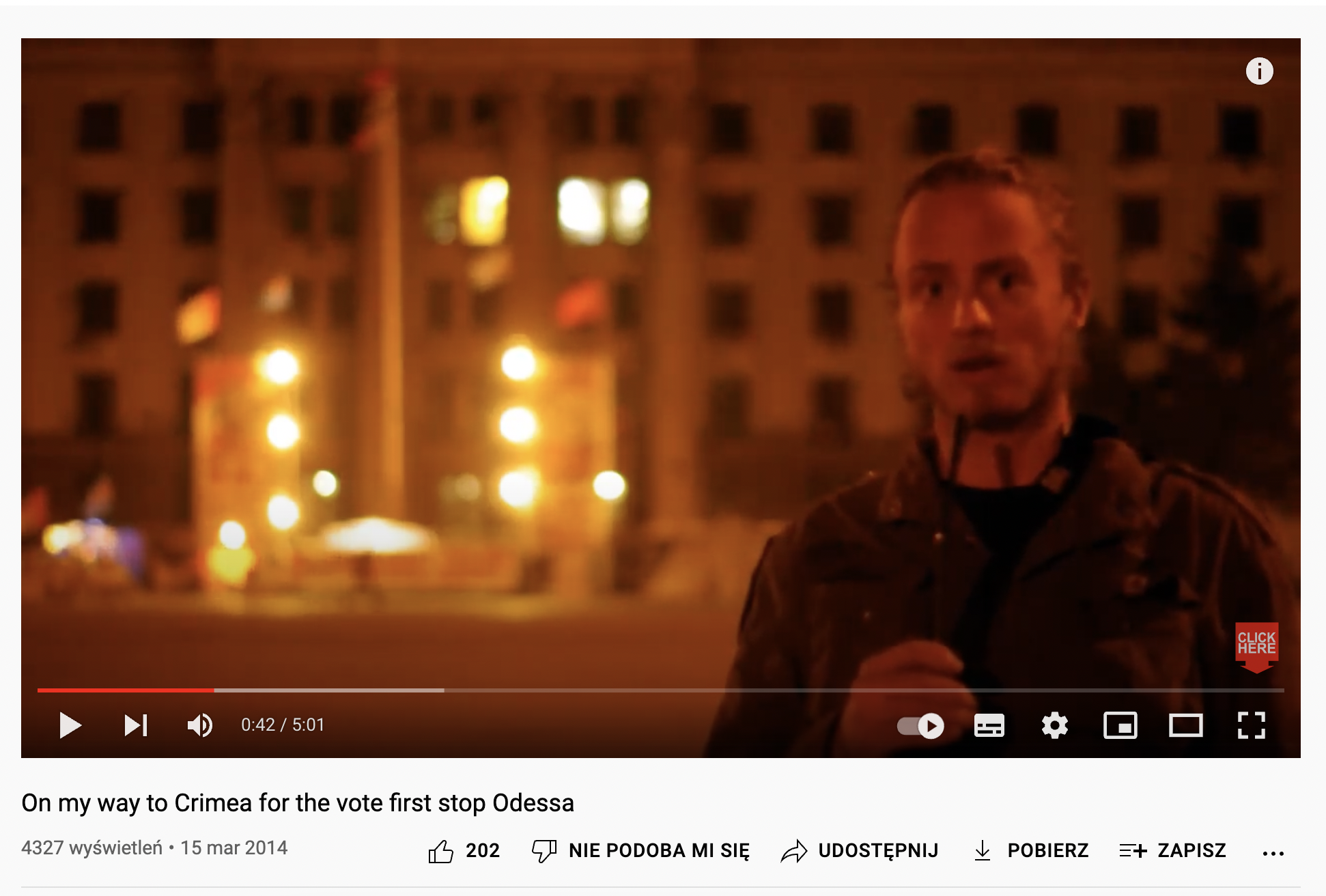
In the video we can hear the statements of two inhabitants of Odessa. The first of them advocates peace and the united Ukraine. However, the second one presents completely different character. The interlocutor talks about the unequal treatment of Russian-speaking residents of Ukraine and “nationalist actions of Kiev”, which he calls Nazi-fascist, and for the events in taking place in Ukraine at that time he blames the United States, who was supposed to finance the conflict.
The second recording was posted on the channel on March 18, 2014, two days after the referendum, in which Crimea’s inhabitants were supposed to vote for the annexation of the region by the Russian Federation. The referendum was conducted under threat of weapons by Russian troops. International viewers were not allowed not only to observe the election process, but also to enter Crimea at all.
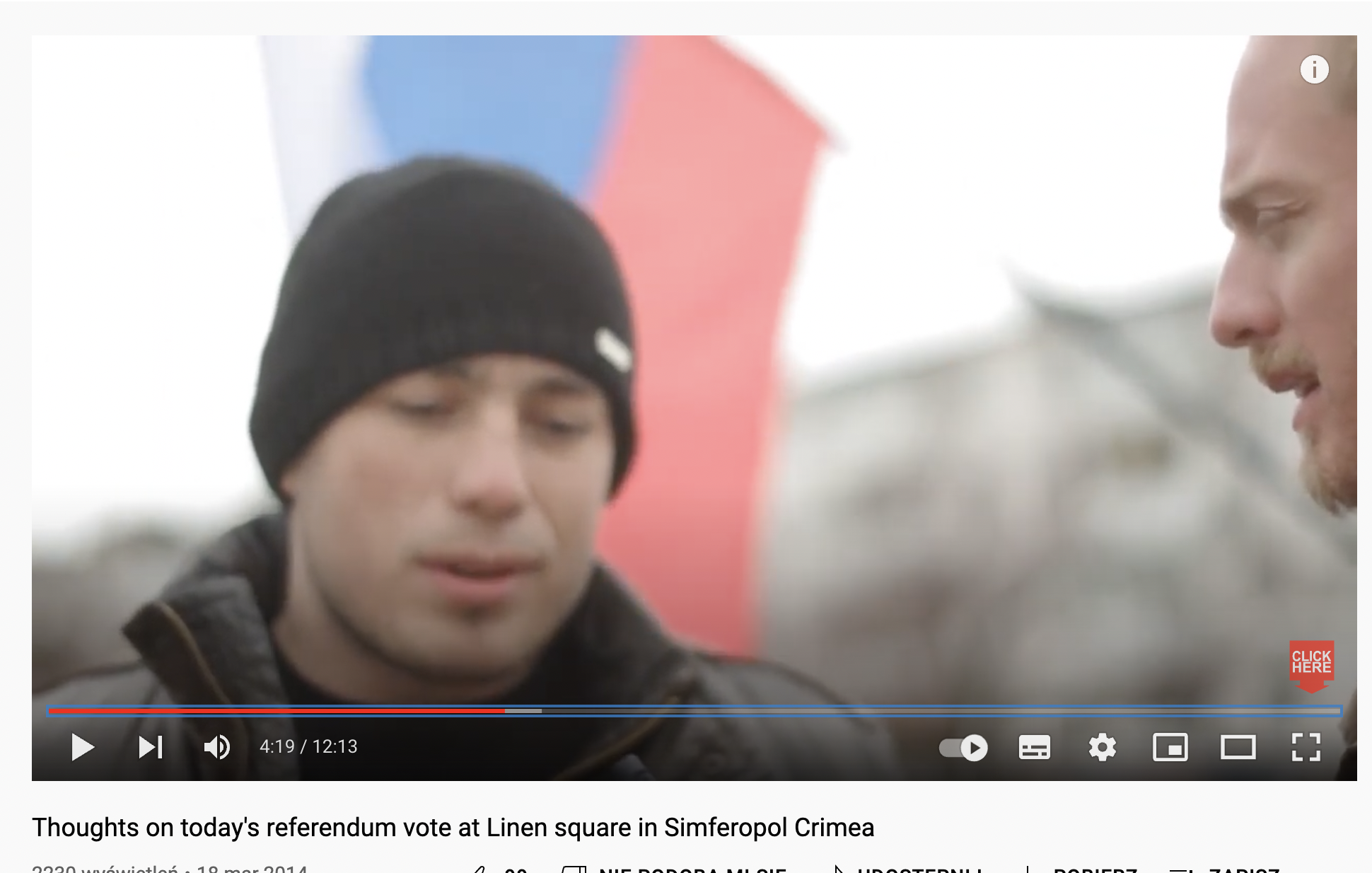
The current Ukrainian authorities deemed the referendum illegal and unlawful, what is more, most experts and international bodies consider the results of the referendum to be falsified. On 27 March 2014, the United Nations adopted Resolution 68/262 on the territorial integrity of Ukraine and the annexation of Crimea by the Russian Federation, which declared the referendum invalid.
The 12-minutes long video posted by Lancaster is actually one statement of a person introduced as an inhabitant of Crimea. It begins with the statement that the elections were fully legal and legitimate, because it was the people, who in a grassroots way decided to hold the referendum. The interlocutor himself, as he declared, voted for the annexation of Crimea to the Russian Federation. As he reasons, Crimea has always belonged to Russia, not only territorially, but also culturally, thus the inhabitants of Crimea decided to join to Russia. As he continues, according to him, the Western media distorts the reality of the Crimean community by not showing the grassroots movements and real social moods. Lancaster’s interlocutor directly describes Ukraine’s government of and its western part’s inhabitants as fascists expressing indeed Nazi claims, he also blames Western Europe and the United States for the conflict in Ukraine.
The next video series [e.g. 1, 2] are interviews with Donetsk’s inhabitants after the declaration of independence by the Donetsk People’s Republic on May 12, also under the referendum and a by the grassroots voice of its inhabitants. This is at least how Lancaster portrays it. It should be briefly added that neither the Donetsk People’s Republic nor the Luhansk People’s Republic (which was established on the same day, i.e. May 12, 2014) are recognized internationally and their formation violates the integrity of Ukraine.
Lancaster’s interlocutors are clearly pro-Russian and happy with the newly formed republic, expressing their cultural and historical ties with Russia and their desire to separate themselves from fascist Ukraine.
Four years after the annexation of Crimea
On Lancaster’s YouTube channel we can find a playlist created in 2018, containing materials aimed at presenting Crimea’s socio-economic situation four years after the Russian annexation.
In one of the videos, in the second minute, Lancaster asks the interlocutor about the referendum from 2014. Then, she admits that she herself voted for the annexation of Crimea by the Russian Federation, which was supposed to be a free choice of the inhabitants of Crimea, who in 95% voted for the annexation.
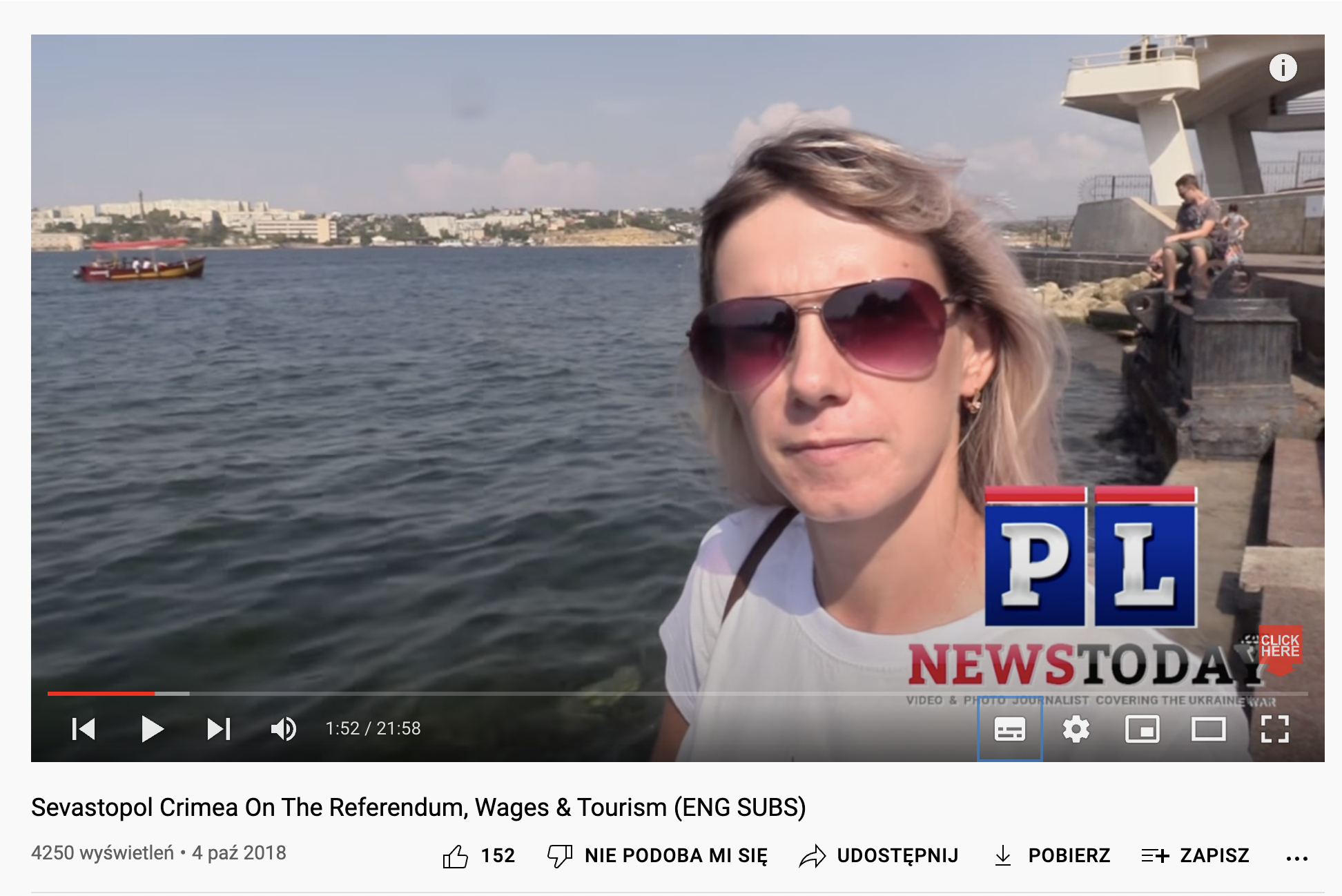
Then, Lancaster points out that the West (in the recording he uses the term The Western Side) and Ukraine do not recognize the legality of the referendum and consider Crimea to be part of Ukraine. The interlocutor replies that it was the people themselves who decided where they want to live and who they want to be, and thus they chose Russia. She also adds that she would like to thank President Putin for allowing the Crimea inhabitants to come back home – to Russia.
In the second part of the video, Lancaster talks with a woman describing herself as a tourist regularly visiting Crimea. Lancaster asks about her opinion on the claim that the West defines Crimea as a dangerous and unstable place with a high risk of a terrorist attack, to which the tourist strongly denies. She considers Crimea a very safe and peaceful place, with an extremely nice and hospitable community. Lancaster then asks her what she thinks about the results and legality of the referendum from 2014. She answers briefly that the referendum reflected the voice of the whole society and surely it was legal, because nobody was forced to anything.
The other statements of the interlocutors in this recording are equivalent, they point to the similarity of Crimean and Russian cultures, and the fact that Crimea’s economic status has clearly improved since its annexation. In another recording, Lancaster talks with a Russian tourist who came from Yekaterinburg to Crimea. She describes the huge socio-economic changes that have taken place since 2014 and believes that Crimea goes through the “reconstruction phase” currently.
In his videos, Lancaster presents Crimea as a stabilized, economically developing region, whose inhabitants have a strong sense of cultural, historical and political community with Russia. The annexation of Crimea to the Russian Federation in 2014 was de facto supposed to develop from grassroots, internal social processes, while the community itself seems to be extremely homogeneous. The picture presented by Lancaster is a one-sided and incomplete representation of the socio-political reality of Crimea.
In four years period after the publication of the material, status of the region in the international arena has not changed, i.e. UN Resolution 68/262 has remained (and still is) in force. Only Afghanistan, Cuba, Nicaragua, North Korea, Venezuela and Russia have officially recognized the Republic of Crimea as part of the Russian Federation.
Crimea is considered to be an unstable and dangerous region, where the political order was held through military forces and the activity of the repressive apparatus. According to the report by the U.S. Department of State, the atmosphere of lawlessness and impunity of local authorities was maintained in the region. Civil liberties have been radically limited in the Republic of Crimea, and repression and violations of human rights have become a tool of power and a goal itself. Persecution and repression mostly affected political opponents and ethnic and national minorities, especially the Crimean Tatars. In addition, as a tool for managing the region’s population, the policy of mass resettlement and relocation began to be used.
Identity policy in self-proclaimed republics
So-called Donetsk and Luhansk People’s Republics – the newly established para-states in the east of Ukraine – had to develop mechanisms to legitimize and strengthen their “statehoods” in order to survive. Thus, the authorities of the republics started to implement newly designed historical and identity politics, the aim of which was creation of the new citizen. This process was described more precisely, from the perspective of four years since the republics was established, by analysts from The Centre for Eastern Studies.
On Lancaster’s channel, we can find a lot of materials showing “public holidays”, such as the recording of the Flag Day in the Donetsk People’s Republic. This material is not a news footage, it does not contain any commentary, but it consists only of shots selected intentionally and the speech of the republic’s authorities. Another similar material is the recording of the official celebration of the “independence day” in Donetsk.
Analysts from the Centre for Eastern Studies indicate that the main axis of the historical policy of the self-proclaimed republics has become the juxtaposition of the “Great Patriotic War” with the current military activities in the region. The fight supported by the West against the “Nazis” and “fascists” from Kiev is compared to the fight of the USSR soldiers during the World War II. This is manifested, for example, by commemorating Soviet heroes with honors, as presented in one of the recordings on the Lancaster’s channel. Another video shows the “March of the Immortal Regiment”, in which participants carry portraits of their grandfathers and great-grandfathers, who took part in World War II.
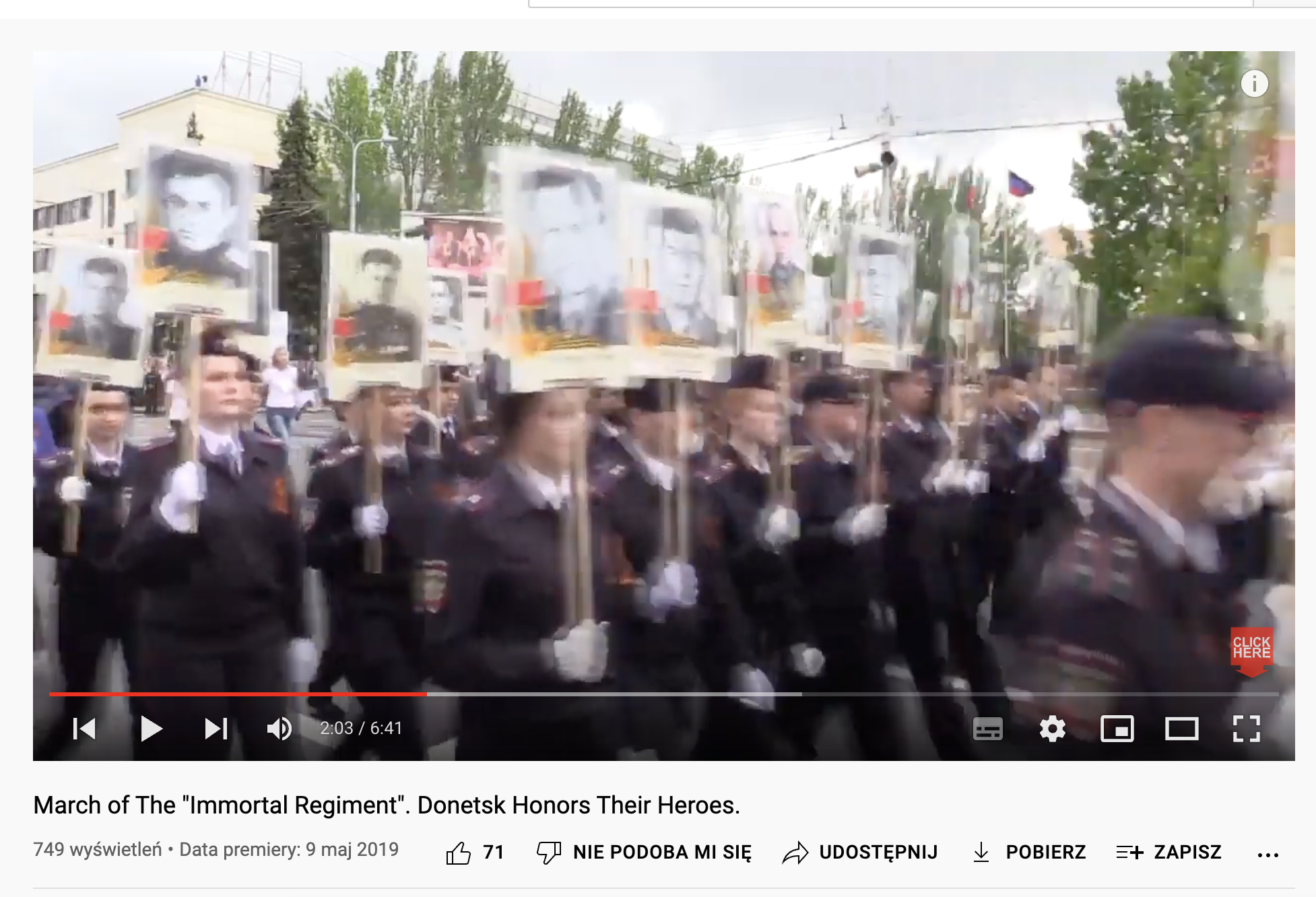
In turn, this material – in its looser, journalistic form – shows excavation works in the location where the Soviet soldiers’ remains from the World War II were found.
It should be added that historical policy (and thus the citizen’s identity policy) in the self-proclaimed republics constitute a reflection of the policies designed by the Kremlin authorities. It all seems to be exactly the opposite of the processes taking place in Ukrainian society during the conflict since 2014.
Conflict in the Nagorno-Karabakh region
On September 27, 2020, tensions between Azerbaijani and Armenian forces escalated in the region of Nagorno-Karabakh. The Azerbaijani-Armenian conflict concerns the para-state of the Nagorno-Karabakh Republic, which is located in the territory of Azerbaijan. The confrontation took form of the regular military clashes, the heaviest since the ceasefire in this region – in 1994. Researchers from the Centre for Eastern Studies indicate that the real parties to this conflict are Russia, supporting Armenia, and Turkey, supporting Azerbaijan. What is interesting, this republic is not recognized even by Armenia itself, although it was “established” by Armenian separatists.
In a video published on April 15, 2021, Lancaster presents, what he calls, “the real social situation of the region.” He stays in Karki [the Armenian government uses the name Tigranashen] – Azerbaijan’s enclave on the territory of Armenia. Two threads appear in the material. Firstly, the territorial affiliation of the enclave to Azerbaijan is questioned and, secondly, the region is presented as historically and culturally belonging to Armenia. In the material, the interlocutors talk about alleged crimes committed by Azerbaijanis.
Recording from October 14, 2020, shows, according to Lancaster, a house demolished during an Azerbaijani bombing, where a 75-year-old man was killed.
The second part of the material is an utterance of a woman talking about the bombing that was supposed to take place two days earlier. As the woman states, the aggressors were supposed to be the Azeris. In another recording, also in this video, Lancaster presents a bombed kindergarten. The video released on October 7, 2020, according to Lancaster, shows evidence of war crimes committed by Azerbaijanis against civilians. The material is supposed to depict the city of Stepanakert after the night bombing. In another, very short video, Lancaster presents some unidentified recordings of military actions, depicting them as an Azerbaijanis’ attack on the inhabitants of Stepanakert.
It is also worth to take a look at the recording, which is different from the abovementioned ones. This time, Patrick Lancaster publishes a video, which is supposed to clearly confirm the historical and cultural belonging of the Nagorno-Karabakh region to Armenia. In the material we see an Armenian monastery from the fifteenth century in Gandzasar, whose history is supposed to indicate Armenian cultural continuity. However, earlier in the material, a statement by a man was blended in, describing how he was defending the monastery and Christians in 1992 against an attack of, as he called, “Islamic terrorists”.
Invasion of Ukraine
On February 24, 2022, the troops of the Russian Federation invaded Ukraine, which was an escalation of the war in eastern Ukraine, ongoing since 2014. The military operations were preceded by the political conflict on the international arena, social unrest and disinformation activities carried out by the Russian side. On February 21, in Vladimir Putin’s address to the nation, he recognized the Donetsk and Luhansk People’s Republics independence and territorial claims, which was a direct sign of the military conflict escalation. The Minister of Foreign Affairs of Ukraine, Dmytro Kuleba, stated on his official Twitter profile that Russia’s recognition of the separatist republics’ statehood has not only a regional, but also a global dimension, and the only way is the political efforts focused on de-escalating the conflict:

Having this context in mind, let’s look at the materials published by Patrick Lancaster directly before the invasion on February 24, 2022.
In a video from January 26, Lancaster presents a communicate of the Donetsk People’s Republic’s authorities, providing information about the Ukrainian troops actions, which was supposed to be the symptom of preparing for a military operation in the republic. The authorities also inform about actions aimed at securing the republic and its people. In the further part of the material Lancaster states that the republic’s citizens do not want the return to Ukraine, that the Donetsk People’s Republic area is in fact the territory of Russia, and its inhabitants feel Russian, the evidence of which is the Russian flag waving in the background and the statue of Lenin standing in the city center.
Two days earlier, i.e. on January 24, a material was published, in which the head of the Donetsk People’s Republic militia says clearly that Ukrainian military aggression on the territories of Donetsk and Luhansk republics would not be left unanswered.
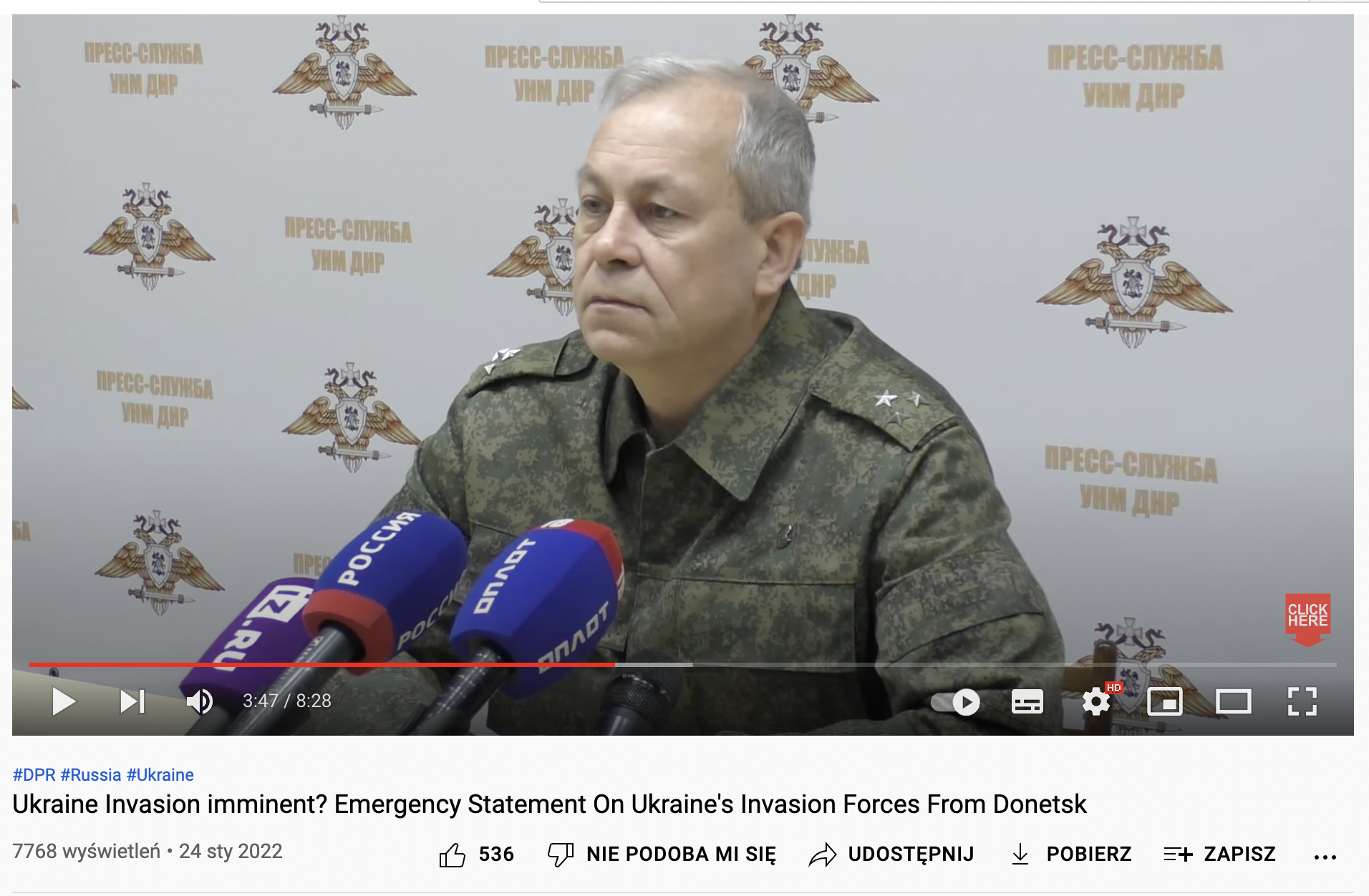
The military reaction is suppose to cause a complete destruction of the Ukrainian army, which is why the head of the militia requests Ukrainian soldiers to desert in order to save their lives. Earlier, Lancaster commented on recent events on the political scene and defined the President Volodymyr Zelenskiy’s words, who spoke about the integrity of Ukraine, as a harbinger of a military invasion of the republics. Lancaster also accuses the government of the United States of escalating the conflict.
On January 28, Lancaster published a recording of the conversation of two soldiers, which as he says, was recorded on the front line between Ukrainian and separatist troops, near Spartak. The soldiers’ statements are very interesting in the context of Lancaster’s overall narrative.
As the first soldier says, he has been fighting since the beginning of the conflict in 2014. The reason for joining the separatist troops was the objection to the ban on the Russian language use, Ukrainian nationalism and the recognition of Bandera as a national hero. He continues with saying that the escalation of the conflict is uncertain and that Russia can come to an agreement with the West. The soldier believes that if no agreement is reached, Ukrainian provocation will probably begin.

The second soldier does not believe in the escalation of the conflict, especially in the post-pandemic time. Asked about the future of the republic, he answers briefly that he hopes for a better tomorrow and that he has never wondered in what country it will arrive – in Ukraine or in the Russian Federation.
Importantly, in none of these statements any identity or patriotic threads appear, the soldiers do not speak directly or declare their nationality and political affiliation. Instead, they manifest the hopelessness of the situation, in which they find themselves.
Lancaster’s reports regarding the alleged provocation of Ukraine were verified by Anye van Wagtendonk and Jason Paladino, and the evidence delivered by Lancaster was considered to be fabricated. The video published on February 23, which was also supposed to depict the Ukrainian provocation, was also checked by Nick Waters in the Bellingcat portal, which proved that these events were fabricated by the Russian side.
On February 26, two days after the beginning of the Russian Federation’s invasion of Ukraine, Patrick Lancaster published a video, in which, according to him, evidence of the use of cluster bombs by the Ukrainian side is shown.
A cluster bomb usually explodes in the air and scatters dozens of small bombs over an area of a football field size. Cluster shells often do not explode on the first clash, leaving unexploded ordnance that act as landmines. Due to the nature of cluster munitions’ operation, its use constitutes a violation of international humanitarian law. The use of cluster bombs is usually an action against the civilian population, which leads to a violation of international law and, as a consequence, can lead to try those responsible for war crimes or crimes against humanity.
In the footage from March 14 Lancaster also accuses the Ukrainian side of using cluster bombs. However, the information and evidences presented by Lancaster have not been confirmed by any other independent sources, state institutions, or NGOs. It is worth noticing that Human Rights Watch has published a report on the use of cluster bombs, which does not confirm the claim that they are used by the Ukrainian side.
A surprising perspective
What seems to highlight the content published by Lancaster the most is the perspective, from which he describes the events. As the only Western journalist (in an overt manner) he was permitted by the Russian Federation’s troops to document their operations. The “journalist” is not reporting on events only from the territories occupied by the Russian Federation, but also directly from the front line, or other areas of military operations. In this recording, from June 12, he accompanies the troops of the Russian Federation during a patrol among the local community.
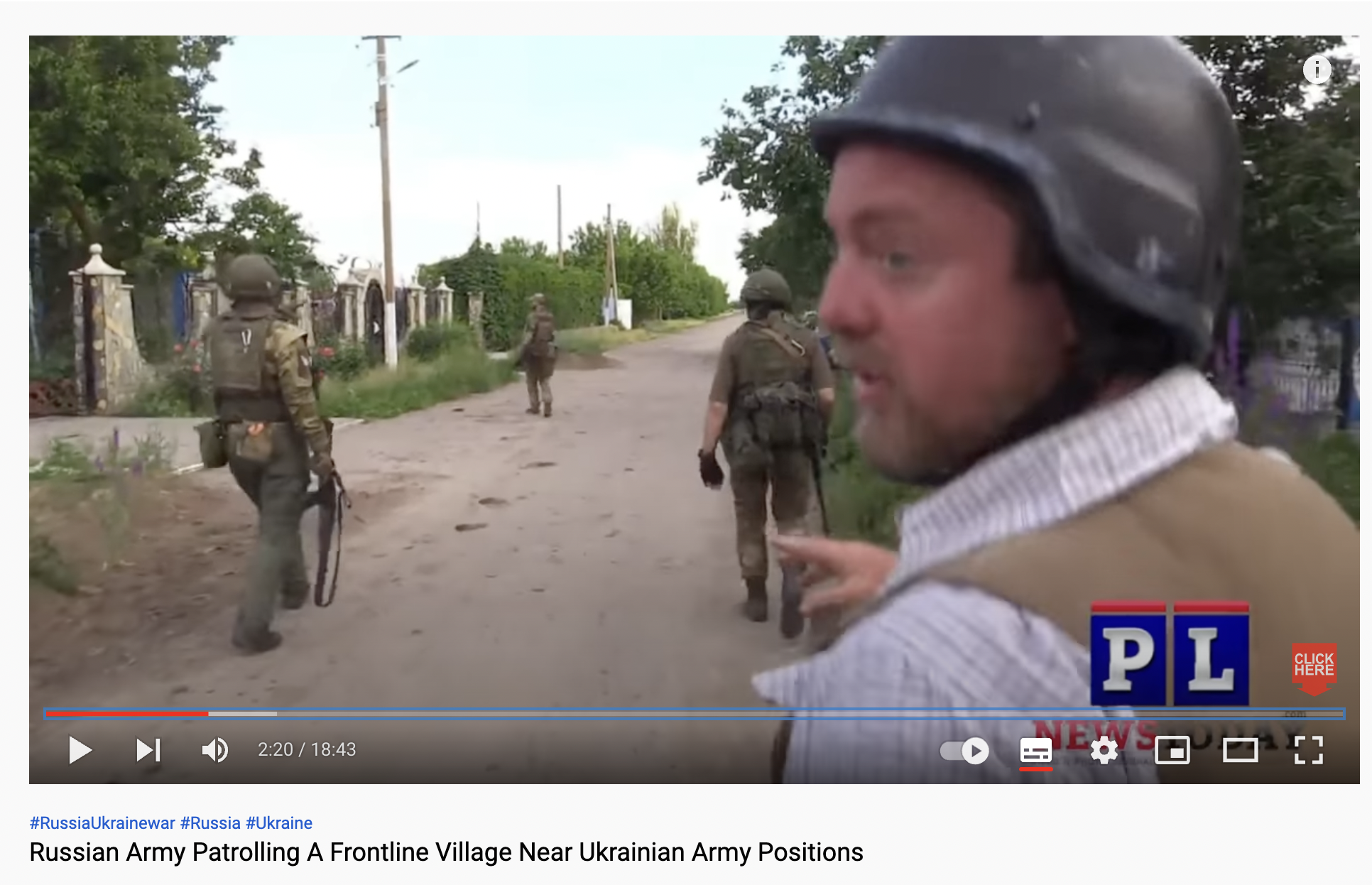
In the footage from June 11, we see Lancaster not only together with the Russian soldiers, but also accompanying them in firing rockets at the Ukrainian side.

In turn, the video from June 2 is a relation from the “everyday life” of separatists fighting on the side of the Russian Federation.
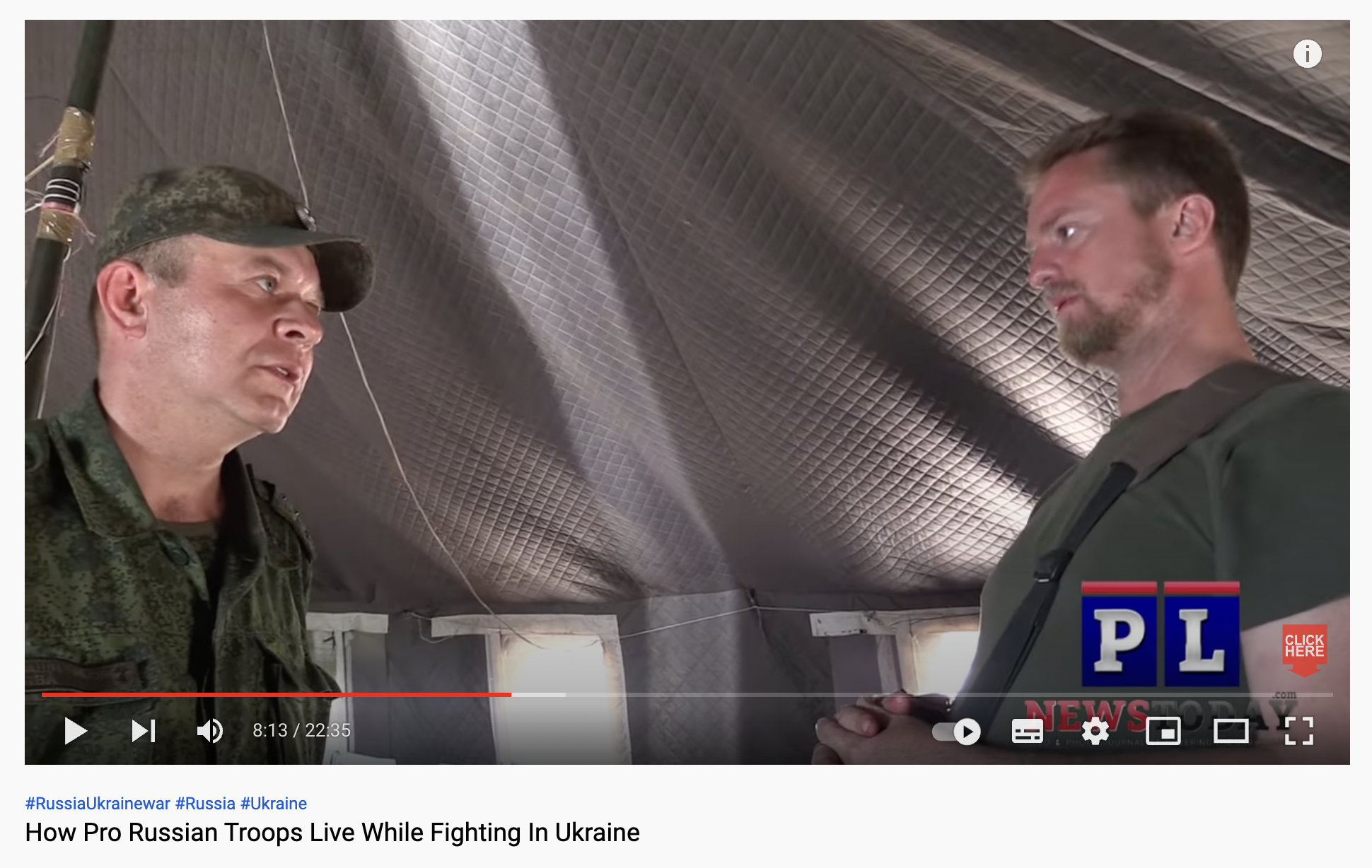
Reality according to Patrick Lancaster
Terms such as pro-Russian, Putin’s, and propagandist do not reflect the figure of Patric Lancaster fully and the image of the world he creates in his materials. The unequivocal claim that the Russian Federation is good and the West is evil does not cover the subject matter. This can be seen only via the long term perspective, overall deconstruction of all Lancaster’s materials, not individual recordings.
The world presented by Lancaster is generally a simple world – black and white, single-threaded. The regions presented in the videos are the border regions, settled in many socio-cultural and historical contexts. These are ambiguous and thus cannot be easily inscribed in the clear-cut categories of identity, nation or country that we deal with every day. The diversity of these regions is shown, among others, by a study on the identity of the inhabitants of Crimea, and by the statements of the separatist republics’ soldiers quoted above, where the identity threads did not resonate unequivocally.
Lancaster shows regions, their stories and communities in a way so that they can be easily fit into a specific scheme and so that the events can then be presented according to a predetermined scenario. His narrative is also in line with the political goals of the Kremlin’s government. Lancaster presents a reality that is designed by the Kremlin’s political apparatus. It’s more than propaganda. Patrick Lancaster’s activity has an ideological dimension. Lancaster implements the imperialist ideology of Russia, designed and implemented by Vladimir Putin.
Sources
Amnesty International: https://www.amnesty.org/en/latest/news/2018/02/crimean-tatar-hrd-emir-usein-kuku/
Charron, A. (2016). Whose is Crimea? Contested Sovereignty and Regional Identity. Region, 5(2), 225–256. http://www.jstor.org/stable/24896628
U.S. Department of State: https://www.state.gov/reports/2018-country-reports-on-human-rights-practices/ukraine/ukraine-crimea/
Handicap International: https://d3n8a8pro7vhmx.cloudfront.net/handicapinternational/pages/269/attachments/original/1369065455/Landmines_Circle_of_Impact.pdf?1369065455
Human Rights Houses: https://humanrightshouse.org/wp-content/uploads/2018/12/web-Crimea-breaking-the-wall-of-silence.pdf
Human Rights Watch: https://www.hrw.org/report/2022/05/11/intense-and-lasting-harm/cluster-munition-attacks-ukraine#_ftn1
Human Rights Watch: https://www.hrw.org/report/2022/05/11/intense-and-lasting-harm/cluster-munition-attacks-ukraine
International Committee of the Red Cross: https://ihl-databases.icrc.org/applic/ihl/ihl.nsf/Treaty.xsp?documentId=00E3441C08D5B5B9C12574C6002EE0D3&action=openDocument
UN Integrity of Ukraine: https://www.un.org/press/en/2022/sgsm21153.doc.htm
UN Resolution 68/262: https://www.un.org/en/ga/search/view_doc.asp?symbol=A/RES/68/262
UN High Commissioner for Human Rights: https://www.ohchr.org/sites/default/files/Documents/Countries/UA/CrimeaThematicReport10Sept2018_EN.pdf
OSW 3: https://www.osw.waw.pl/sites/default/files/prace_64_pl_cwiercwiecze_ukrainy_net.pdf
OSW YouTube 1: https://www.youtube.com/watch?v=7VFNAKI3XY0
OSW YouTube 2: https://www.youtube.com/watch?v=_m-GUVIZoNc
OSW YouTube 3: https://www.youtube.com/watch?v=nSExHBMv7N8
Parliament’s report EU: https://www.europarl.europa.eu/RegData/etudes/STUD/2016/578003/EXPO_STU(2016)578003_EN.pdf
Ukrainform: https://www.ukrinform.net/rubric-polytics/2740372-sniper-deki-who-turned-into-a-journaliie.html
